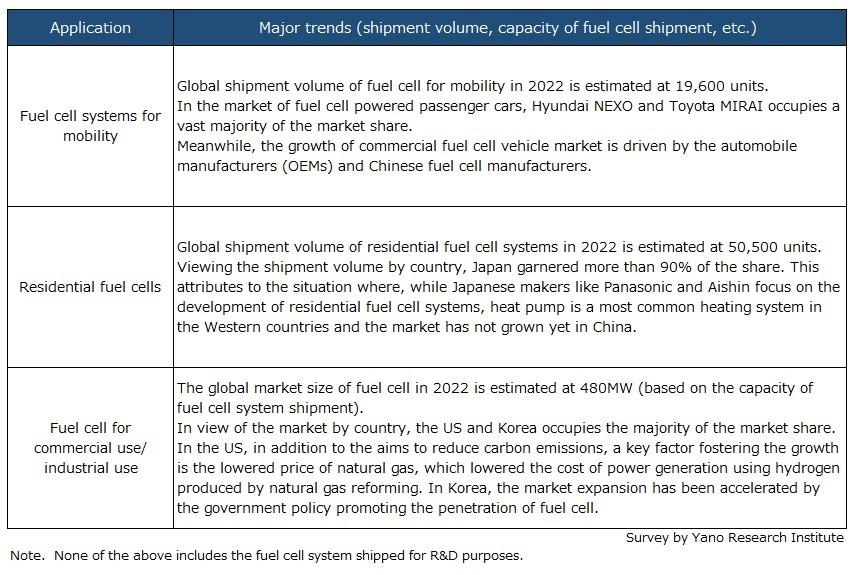No.3274
Global Market of Fuel Cell Systems & Related Components: Key Research Findings 2023
Global Fuel Cell System Market Foresees Growth Driven by Commercial Fuel Cell Vehicles and Fuel Cell Systems for Commercial/Industrial Applications
Yano Research Institute (the President, Takashi Mizukoshi) has conducted a survey on the global market of fuel cell system and related components, and found out the policy trends in fuel cells/ fuel cell powered by hydrogen in each country, the market by application, the related components, and the trends of manufacturers. This press release announces the trends of fuel cell system for mobility, residence, and commercial/industrial applications.

Market Overview
While more than 150 countries around the world set carbon neutrality goals in the process of striving to reduce carbon emissions, hydrogen is becoming increasingly important as carbon-neutral fuel. Policies for mass production of green hydrogen are seen in many countries in particular. In response to the situation, fuel cell systems that produce energy using hydrogen is in the spotlight once again, and the trend has been leveraging the growth of global fuel cell system market in full-scale. By application, the fuel cell systems for mobility (commercial vehicles) and for commercial/industrial applications are expected to boost the growth of the fuel cell market.
Noteworthy Topics
Current Status of Global Mobility Fuel Cell Market
Global shipment volume of fuel cell systems for mobility in 2022 is estimated at 19,600 units, up 11% from the preceding year. As a total of fuel cell system for passenger cars and for commercial vehicles, the market of fuel cell systems for mobility has been growing continually from 2020. Nevertheless, the fuel cell for passenger cars, which dominates the majority of the shipment volume, has declined slightly in 2022 due to its heavy dependence on the sales performance of particular OEMs (automobile manufacturers). Meanwhile, the fuel cell systems for commercial vehicles are expanding, primarily in China. The shipment volume of fuel cell for commercial vehicles is projected to exceed that of fuel cell for passenger cars by around 2025.
Future Outlook
To achieve carbon neutrality, it is critical to adopt the right means from a variety of options that suits to specific needs and conditions in different parts of the world.
Fuel cell is seen as one of the promising options to reach net-zero. The market for fuel cell systems and components is projected to prevail in full-scale beginning around 2030, with the development of hydrogen infrastructure and technology advancements.
Research Outline
2.Research Object: Manufacturers and suppliers of fuel cell systems and related components, research institutions including universities
3.Research Methogology: Face-to-face interviews by our expert researchers (including online interviews) and literature research.
What is the Fuel Cell Systems & Related Components?
In this research, the fuel cell system indicates the fuel cell deployed as power source for mobility, residence, commercial/industrial use, and other applications.
The related components refer to main components of PEFC (Polymer Electrolyte Fuel Cell), such as electrolyte membrane, catalyst layer, gas diffusion layers (GDLs), separators, and catalyst-coated membranes (CCM)/membrane electrode assembly (MEA), and chief components of SOFC (Solid Oxide Fuel Cell), including electrolyte, fuel electrodes, oxygen electrodes, and separators (interconnect).
<Products and Services in the Market>
Fuel cell vehicles (FCV), home-use fuel cell system, fuel cell system for commercial /industrial application, fuel cell for other applications (industrial machinery, construction machinery, farm equipment, port vehicles [ship loading/unloading], portable generator, drone, aircraft, vessel, train, motorcycle, and power-assisted bicycle), main components of PEFC (electrolyte membrane, catalyst layer, GDLs, separators, and CCM/MEA, and main components of SOFC (electrolyte [solid oxide], fuel electrodes, oxygen electrodes, and separators [interconnect]).
Published Report
Contact Us
The copyright and all other rights pertaining to this report belong to Yano Research Institute.
Please contact our PR team when quoting the report contents for the purpose other than media coverage.
Depending on the purpose of using our report, we may ask you to present your sentences for confirmation beforehand.